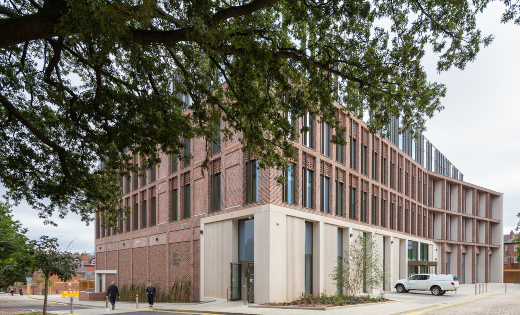Leeds alumna honoured on International Women’s Day
The Esther Simpson Building – named in honour of an heroic graduate who helped countless academics flee totalitarian regimes across the world – has been officially opened on International Women’s Day.
A blue plaque was unveiled for Esther Simpson at the new building’s official opening ceremony (photo credit: Dustin Smith, Skywall Photography)

Esther graduated in 1924 with first class honours in French and German, going on to spend much of her life helping scholars flee persecution.
She played a leading role in helping some 1,500 academics escape from Nazi Germany and, among the refugees she aided during her incredible career, she could count 74 Fellows of The Royal Society, 34 Fellows of the British Academy and 16 Nobel Prize winners.
Vice-Chancellor, Professor Simone Buitendijk, unveiled a Leeds Civic Trust blue plaque dedicated to Esther during a special ceremony on Tuesday 8 March, held to coincide with International Women’s Day.
She said: “Esther Simpson’s achievements were truly incredible. We are so pleased to be able to honour her – an alumna of the University of Leeds – on International Women’s Day.
“Her commitment to helping academics, wherever they were in the world, find refuge and keep sharing knowledge will continue to be a source of inspiration for future generations at the University of Leeds.”
International Women’s Day, held annually, celebrates women’s achievements and increases their visibility, while calling out inequality.
Colleagues from across the University were involved in marking the day with a series of events. The Parkinson Building was also lit up in the suffragette colours of green, white and purple in honour of the occasion.
Marking the opening
 The plaque honouring Esther (photo credit: Leeds Civic Trust)
The plaque honouring Esther (photo credit: Leeds Civic Trust)
The blue plaque follows the unveiling of another last December – honouring Fanny Passavant, the University’s first librarian – and marks Esther’s achievements, as well as her lasting impact on UK academia.
The timing is fitting, given her efforts in helping refuge-seeking academics, and International Women’s Day’s mission to celebrate noteworthy achievements.
The plaque reads:
ESTHER SIMPSON OBE
This graduate of the University of Leeds was born in nearby Little London to immigrant parents.
She was appointed Assistant Secretary to the Academic Assistance Council in 1933.
Through her work in the decades that followed, the hundreds of refugee scholars she saved from persecution and death included sixteen future Nobel Laureates.
1903-1996
Martin Hamilton, Leeds Civic Trust Director, said: “It is no exaggeration to say that without Esther’s work, human knowledge would not be where it is today.
“Scholars from Nazi-occupied Europe were able to continue their work in safety in the UK and the US. After the war, many others from war-torn locations across the world were able to escape persecution.
“The work she did to protect scholars from around the world is perhaps the academic equivalent of the ‘kindertransport’ programme. We are honoured to support this blue plaque unveiling.”
Building on the strategy
 The Esther Simpson Building (photo credit: University of Leeds)
The Esther Simpson Building (photo credit: University of Leeds)
Construction of the Esther Simpson Building was completed for Leeds University Business School and the School of Law last September.
In line with both the University’s determination to build a fairer future for all and to redefine the curriculum, it houses transformative and flexible teaching spaces that are designed help to better equip students for working collaboratively.
One of the latest additions to the collection of public artwork on campus – ‘To Leaf is to Learn’, created by Juanjo Novella in collaboration with Poet Laureate and the Professor of Poetry at Leeds, Simon Armitage – can be found just outside the building.